Day 1 of a three day long weekend of Spring Migration tours today. It was forecast to rain today, and it did, but thankfully it was never as heavy as we had been promised. We met in Wells and headed east along the coast in search of migrants.
As we drove along the coast road, it was overcast and damp. At Walsey Hills, a small group of Swallows and Sand Martins had gathered on the wires. There are lots of our breeding hirundines in now, so these could have been locals or birds stopping off on their way further north.
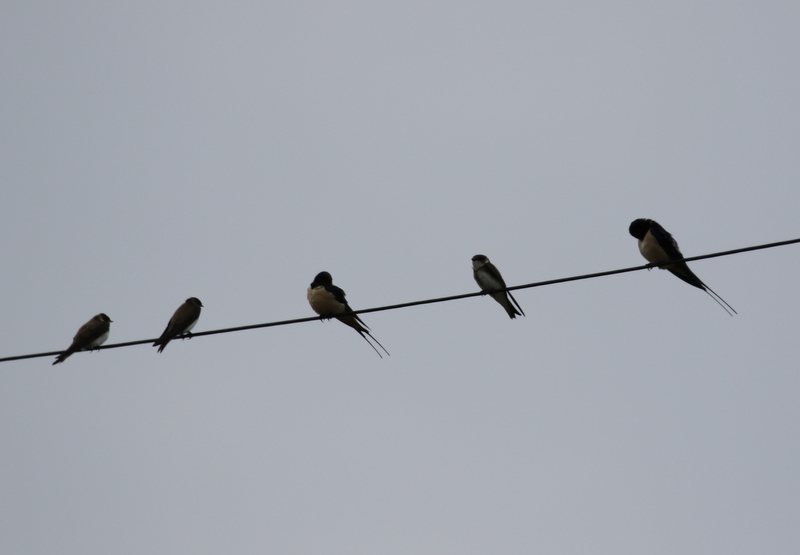 Swallows & Sand Martins – on the wires at Walsey Hills
Swallows & Sand Martins – on the wires at Walsey Hills
Our first stop was at Kelling. A Song Thrush was singing half-heartedly by the school. A little further along, we could hear a Lesser Whitethroat singing from the hedge across the other side of the field and then a Chiffchaff started up from the bushes by the lane. Many of the first warblers are now back on territory, and newly arrived they will often sing almost regardless of the weather.
From the first gate overlooking the Water Meadow, a scan of the fields revealed a pair of Mediterranean Gulls. Both adults, we got them in the scope and could see their jet black hoods and white wing tips. Otherwise, the Water Meadow itself looked fairly quiet from here at first. On the other side of the lane, a ‘dopping’ of Shelducks had gathered in a field and were inspecting the rabbit burrows along the edge for suitable nest sites.
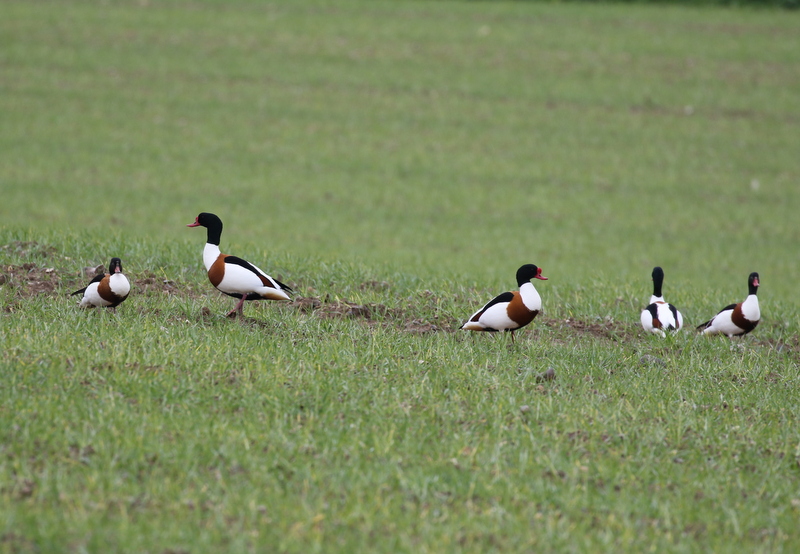 Shelducks – pairing up and looking for nest sites
Shelducks – pairing up and looking for nest sites
Another small warbler flicked across the path and disappeared into the alexanders on the other side. When we got up to where it had gone, we finally managed to get a good look at it and could see that it was a Willow Warbler. Presumably a migrant, it was feeding actively in the dense vegetation alongside the hedge. We followed it for a while, getting occasional views of it as it worked its way to the edge. As it continued up along the hedge row, it gave a quick burst of song. A Goldcrest came down the hedge the other way and landed in the top of a hawthorn beside us – possibly also a migrant, stopping to feed up before heading out across the North Sea.
 Willow Warbler – feeding in the alexanders by the path
Willow Warbler – feeding in the alexanders by the path
We had really hoped to find the Yellow Wagtails which have been here for a couple of days now and just as we got to the end of the tall hedge, so that we could see out across the Water Meadow again, we heard them calling. They came up out of the rushes and flew round. Most dropped straight down back out of view in the tall grass, but three landed on the top of some tall posts. Even better, the Blue-headed Wagtail which has been in with them was one of the three! Through the scope, we could see it’s dark blue-grey cap and contrasting white supercilium, a smart male. Then it dropped down out of view as well.
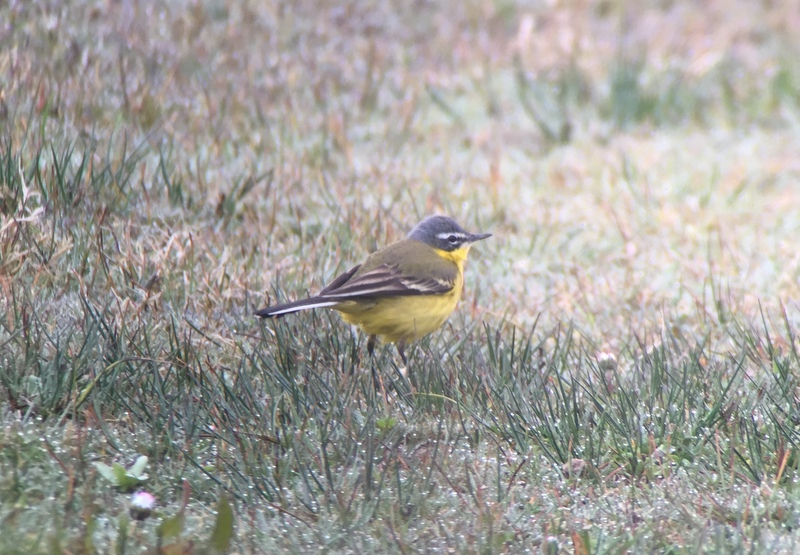 Blue-headed Wagtail – here’s a photo of it from yesterday
Blue-headed Wagtail – here’s a photo of it from yesterday
Several of the Yellow Wagtails flew out and landed on the short grass by the pool, so we could get a better look at them. Bright dayglo yellow, they looked stunning running around among the daisies. But the Blue-headed Wagtail did not come out to join them.
There were several other birds on the Water Meadow. The resident pair of Egyptian Geese have four goslings. There were also a few Gadwall, Teal and Shoveler, and a couple of Avocet too. There were lots of Sand Martins hawking for insects low over the water and a single House Martin flew in to join them, flashing its white rump patch. A Common Whitethroat started calling from the bushes behind us, before flying out onto the brambles and bursting into song – another of the warblers to have returned for the summer just in the last couple of days.
Round by the Quags, a male Stonechat was perched on a post at the edge of the sheep field. It kept dropping down to the short grass to feed. There were lots of Meadow Pipits and Linnets along the path up the hill and at least seven Wheatears in the sheep field from the top path. They seemed to be trying to stay just out of view, over the crest of the ridge, but thankfully they kept running out where we could see them.
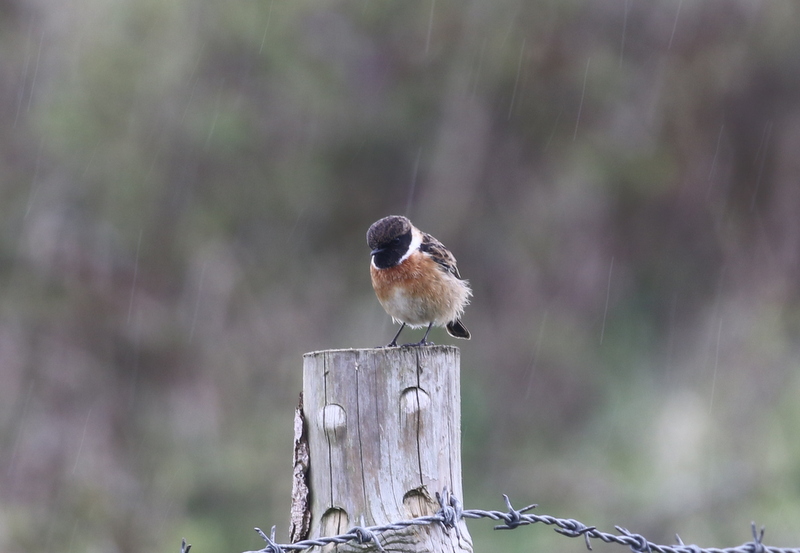 Stonechat – a male, down by the Quags
Stonechat – a male, down by the Quags
A large white bird came high overhead, heading west. Head – and long bill – held stretched out in front and long legs trailing behind, it was a Spoonbill. It didn’t show any signs of stopping, but carried straight on towards Salthouse. We figured it might eventually come down over towards Cley, so thought we would have a look for it on our way that direction later.
There had been no more than light drizzle so far, but it started to rain a little harder now, so we turned round and started to make our way back. We thought perhaps more of the wagtails might have come out onto the short grass, where it was not so wet, but once again there were only a few Yellow Wagtails out in view.
Back at the gate, we stopped for another last scan and a pale shape dropping down into the grass, out of the brambles at the back caught our eye. When it flew back up again we could confirm what it was, a female Common Redstart. This bird was in exactly the same place yesterday, but despite looking on our way past this morning, we hadn’t seen it. It had been very hard to see yesterday too though, and kept disappearing into the brambles or flying over the top into the other side, on the edge of the sheep field, out of view. As it flew between the fence posts, we could see the flash of its orange-red tail and eventually it perched up on the brambles for a few seconds so that we could get it in the scope. Redstart is always a very nice spring migrant to catch up with, as they can be tricky to see at this time of year here.
Our next stop was at Salthouse, down at the end of Beach Road. Scanning from the car, we could see lots of Wheatears out on the short grass, at least a dozen. One or two were a bit nearer to the road, so we got out for a closer look.
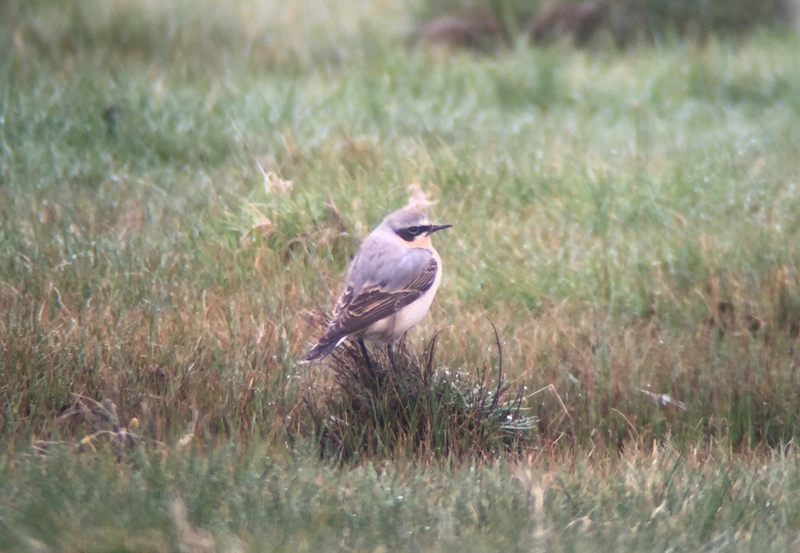 Wheatear – at least a dozen were at Salthouse today
Wheatear – at least a dozen were at Salthouse today
Thankfully, we didn’t have to go far from the car, as it was raining a little more persistently now – all the action here came to us! Three more Yellow Wagtails flew in and landed close by as well. Further over, we could see a White Wagtail as well – its pale silvery-grey back contrasting with the black cap, setting it immediately apart from its close relative the Pied Wagtail.
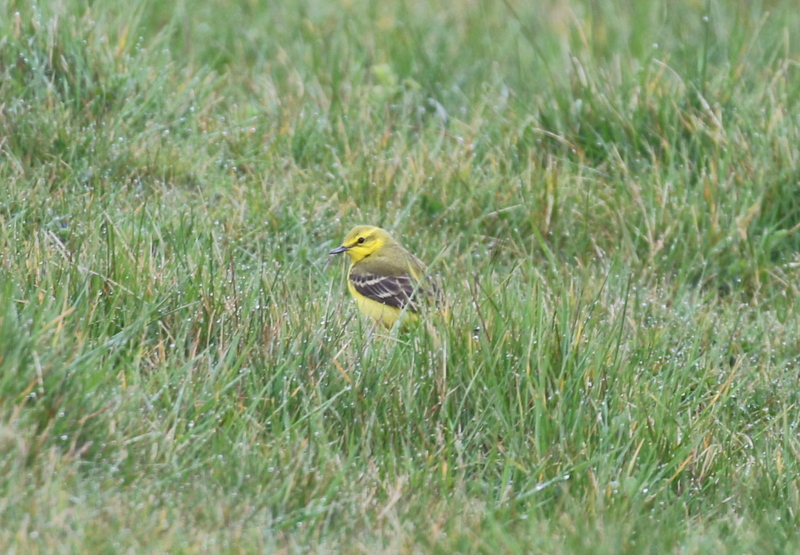 Yellow Wagtail – three were at Salthouse too
Yellow Wagtail – three were at Salthouse too
It is not just passerines on the move or arriving for the breeding season, waders are a feature of spring too. A Little Ringed Plover was feeding down by one of the small pools in the grass. Through the scope, we could see its golden yellow eye-ring. We could hear the distinctive laughing call of a Whimbrel approaching and looked up to see it fly west overhead. From the other direction, we heard a Greenshank calling and turned round to see two fly in from the west and drop down on one of the pools over by the shingle ridge. Both the Whimbrel and the Greenshanks are just stopping off here on their way further north.
 Greenshanks – these two dropped into the pools by the beach at Salthouse
Greenshanks – these two dropped into the pools by the beach at Salthouse
Making our way further back west, a quick stop by Walsey Hills for a scan and we relocated the Spoonbill we had seen flying over earlier. It was out on the pool at Pope’s Marsh and doing what Spoonbills like to do most – sleeping! We had a look at it through the scope, although it wouldn’t show off its bill for us.
 Spoonbill – sleeping out on Pope’s Marsh
Spoonbill – sleeping out on Pope’s Marsh
After a break for lunch, we set out to explore the reserve at Cley. The rain had eased off a bit now, but it was still nice to get into the shelter of the hides. Pat’s Pool held a good selection of waders. A Ruff was right down at the front with a couple of Redshank.The male Ruff are in the process of moulting into summer plumage now, and were a mixture of blotchy colours.
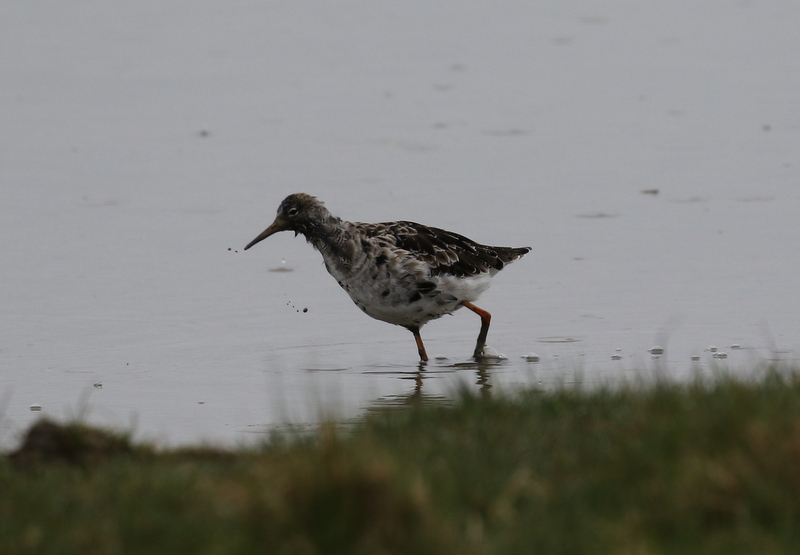 Ruff – just moulting into summer plumage
Ruff – just moulting into summer plumage
We eventually found the Green Sandpiper when it walked out of a sheltered bay, into view. The lack of the white ‘spur’ on the side, between the breast and wings, is a good way to distinguish from Common Sandpipers at a distance. A couple of Snipe were lurking round the edges of the scrape. There are no shortage of Avocets here now – paired up and ready for the breeding season.
 Avocet – there are lots on the scrapes now
Avocet – there are lots on the scrapes now
There are always plenty of Black-tailed Godwits here, and most of them are looking very smart now, having moulted into summer plumage. However, one of the godwits stood out, with deep rusty underparts extending right down under the tail, whereas a Black-tailed Godwit should have a black-barred white belly. This was a very smart summer plumage male Bar-tailed Godwit. Round on Simmond’s Scrape, another Bar-tailed Godwit was lacking any deep rusty colour below, a female.
 Black-tailed Godwit – looking smart in summer plumage
Black-tailed Godwit – looking smart in summer plumage
Also on Simmond’s Scrape, there was a group of smaller waders on the mud on one side. Including at least 12 Dunlin, many of these were also started to attain breeding plumage, sporting small black belly patches and increasingly brightly coloured upperparts. In with them were several Ringed Plovers. A few Lapwing were on the grassy bank in front of the hide.
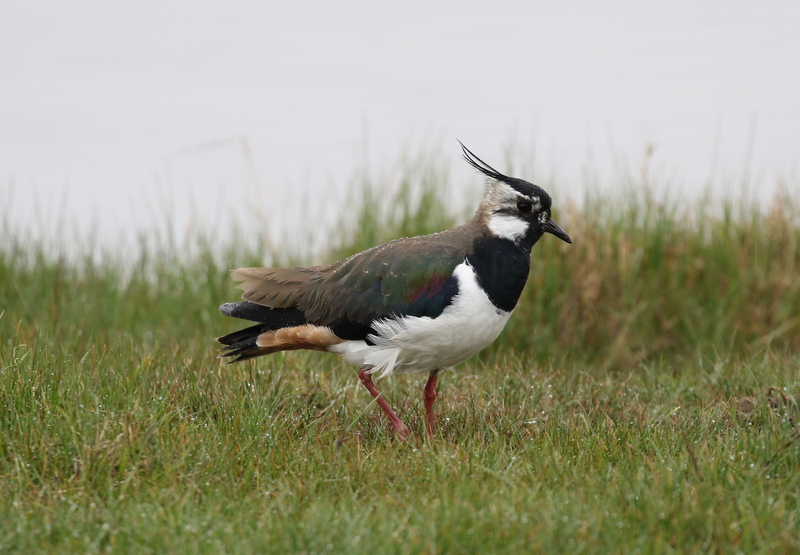 Lapwing – on the bank right in front of the hide
Lapwing – on the bank right in front of the hide
Given the rain, we had not seen any raptors so far today, but once it eased off a bit, the first Marsh Harrier flew in over the scrape and landed in one of the bushes in the reedbed beyond. A Water Rail squealed from the reeds but did not show itself.
Back to the car, and we had a quick drive round to the beach car park to see if there were any migrants around the Eye Field, but it looked pretty quiet here today so we didn’t linger. A Sparrowhawk perched on a gate by the road meant that the detour was worthwhile.
We rounded off the day with a walk out along the East Bank. There were several Marsh Harriers up now, quartering over the reedbeds on either side.The Spoonbill had disappeared, but a few Wigeon out on Pope’s Marsh were new for the day, and a couple more Little Ringed Plovers were out in the grass.
 Marsh Harrier – several came out once the rain eased
Marsh Harrier – several came out once the rain eased
We took advantage of the new shelter and had a good look at Arnold’s Marsh. There were lots of Dunlin and Ringed Plover out on here, as well as more Bar-tailed Godwits, Redshank and Curlew. A single Grey Plover was also an addition to the day’s list.
We had time for a quick look at the sea. All we could see at first were a few Cormorants, but then three ducks appeared, a drake and two female Common Scoter. They were diving continually, which made them hard for everyone to get onto at first. A single Red-throated Diver flew past. Then it was time to head back.
The weather had been far from perfect, but the rain had not really been bad all day today – and we had managed a very decent haul of birds despite the conditions. Once again, well worth going out!
















